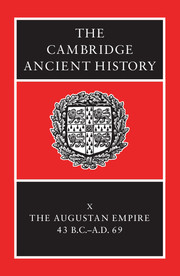BIBLIOGRAPHY
from PART IV - ROMAN SOCIETY AND CULTURE UNDER THE JULIO-CLAUDIANS
Published online by Cambridge University Press: 28 March 2008
- Type
- Chapter
- Information
- The Cambridge Ancient History , pp. 1006 - 1137Publisher: Cambridge University PressPrint publication year: 1996

